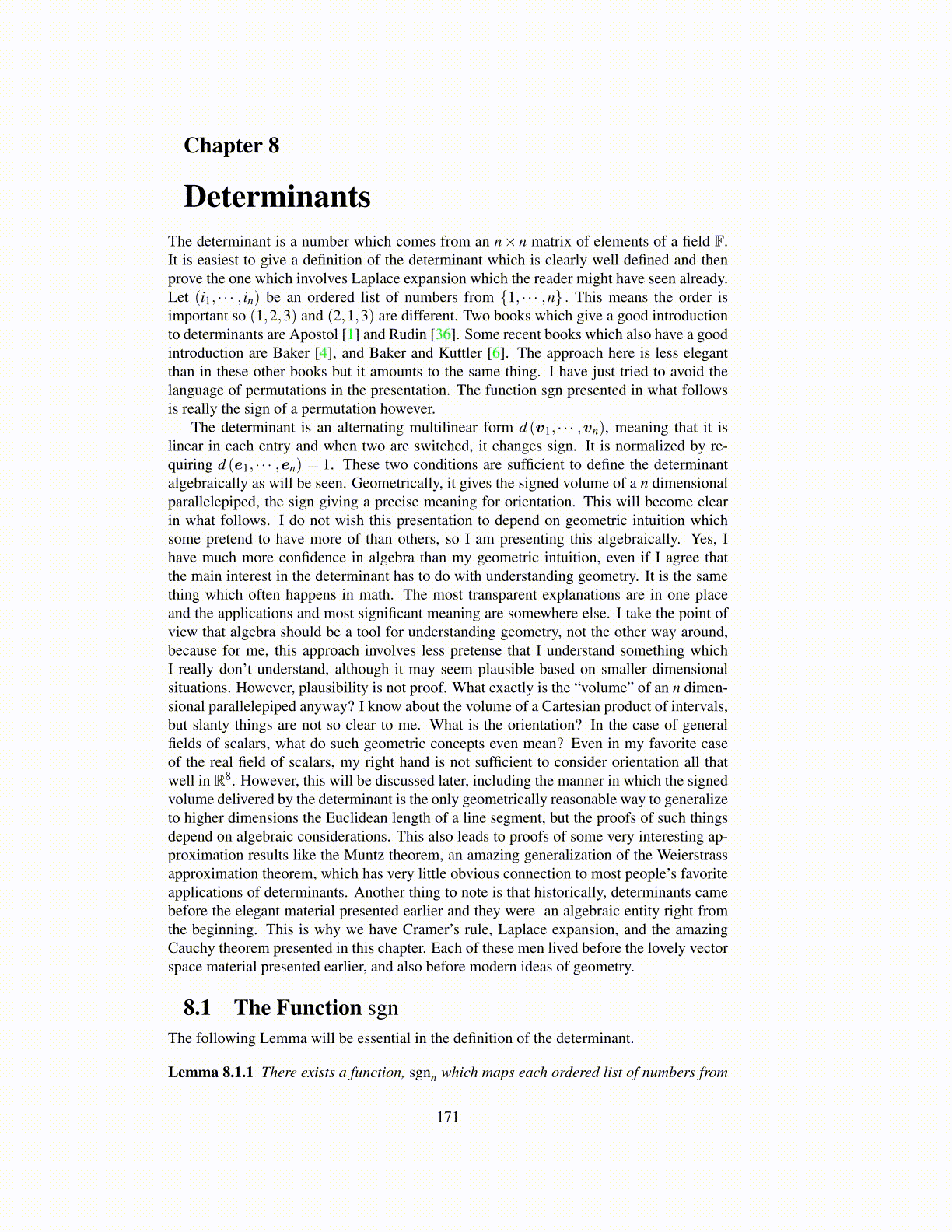
Chapter 8
DeterminantsThe determinant is a number which comes from an n× n matrix of elements of a field F.It is easiest to give a definition of the determinant which is clearly well defined and thenprove the one which involves Laplace expansion which the reader might have seen already.Let (i1, · · · , in) be an ordered list of numbers from {1, · · · ,n} . This means the order isimportant so (1,2,3) and (2,1,3) are different. Two books which give a good introductionto determinants are Apostol [1] and Rudin [36]. Some recent books which also have a goodintroduction are Baker [4], and Baker and Kuttler [6]. The approach here is less elegantthan in these other books but it amounts to the same thing. I have just tried to avoid thelanguage of permutations in the presentation. The function sgn presented in what followsis really the sign of a permutation however.
The determinant is an alternating multilinear form d (v1, · · · ,vn), meaning that it islinear in each entry and when two are switched, it changes sign. It is normalized by re-quiring d (e1, · · · ,en) = 1. These two conditions are sufficient to define the determinantalgebraically as will be seen. Geometrically, it gives the signed volume of a n dimensionalparallelepiped, the sign giving a precise meaning for orientation. This will become clearin what follows. I do not wish this presentation to depend on geometric intuition whichsome pretend to have more of than others, so I am presenting this algebraically. Yes, Ihave much more confidence in algebra than my geometric intuition, even if I agree thatthe main interest in the determinant has to do with understanding geometry. It is the samething which often happens in math. The most transparent explanations are in one placeand the applications and most significant meaning are somewhere else. I take the point ofview that algebra should be a tool for understanding geometry, not the other way around,because for me, this approach involves less pretense that I understand something whichI really don’t understand, although it may seem plausible based on smaller dimensionalsituations. However, plausibility is not proof. What exactly is the “volume” of an n dimen-sional parallelepiped anyway? I know about the volume of a Cartesian product of intervals,but slanty things are not so clear to me. What is the orientation? In the case of generalfields of scalars, what do such geometric concepts even mean? Even in my favorite caseof the real field of scalars, my right hand is not sufficient to consider orientation all thatwell in R8. However, this will be discussed later, including the manner in which the signedvolume delivered by the determinant is the only geometrically reasonable way to generalizeto higher dimensions the Euclidean length of a line segment, but the proofs of such thingsdepend on algebraic considerations. This also leads to proofs of some very interesting ap-proximation results like the Muntz theorem, an amazing generalization of the Weierstrassapproximation theorem, which has very little obvious connection to most people’s favoriteapplications of determinants. Another thing to note is that historically, determinants camebefore the elegant material presented earlier and they were an algebraic entity right fromthe beginning. This is why we have Cramer’s rule, Laplace expansion, and the amazingCauchy theorem presented in this chapter. Each of these men lived before the lovely vectorspace material presented earlier, and also before modern ideas of geometry.
8.1 The Function sgnThe following Lemma will be essential in the definition of the determinant.
Lemma 8.1.1 There exists a function, sgnn which maps each ordered list of numbers from
171